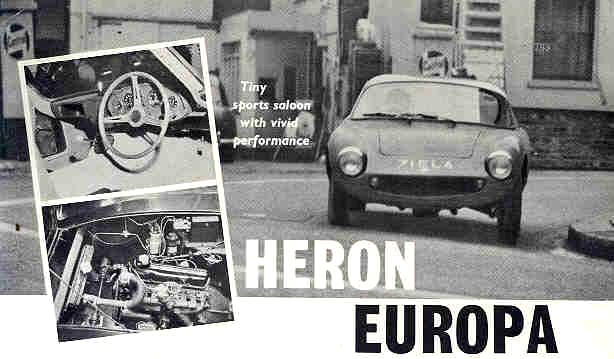
For sheer joy of driving,
the Heron Europa would take some beating. That
was the unanimous verdict of the members of the
Practical Motorist test team who drove this
diminutive sports saloon towards the tail end of
this winter snowfall period.
This had its advantages
– no sterner test of the handing of the car
could have been provided than was offered by the
treacherous ice-bound roads. Unfortunately it
also had the disadvantage that no performance
figures could be obtained, save for timed
“mph per 1,000rpm” data from which the
probable peak performance figures could be
obtained.
In the Europa, Heron have
concentrated on providing just sufficient
accommodation for two people; a Ford Classic
1340cc engine (or a Ford 105E Anglia unit of
997cc); and a rear compartment capable of taking
a reasonable amount of luggage. The result is a
car which is tiny in dimensions – motor
cyclists tower above its 3ft 9in roof line –
but which is netherless comfortable to ride in.
And by keeping the aerodynamic resistance and the
weight to a minimum they have contrived to
produce an over 90 mph car with vivid
acceleration, yet without resorting to any engine
tuning whatsoever. Thus reliability and a very
fair measure of economy are added to the
Europa’s virtues.
The first impression given
by the car after one has mastered the knack of
sliding into the cockpit through the rather
shallow door – is that a very great deal of
thought indeed has gone into devising a driving
layout which will permit hairline control. And
the second is surprise that, despite the rakish
build, one is not conscious of sitting unduly
near the road. The field of view is excellent,
and would be better if the rear window –
very generously proportioned – were of
safety glass instead of Perspex.
One driver – a size 11
shoe man – experienced a certain amount of
discomfort through being unable to rest his left
foot anywhere other than on the clutch pedal.
That apart, the long arm position; the placing of
the pedals; and the support offered by the
tailored seats won general approval.
High geared steering in
combination with Herald based all independent
suspension made the Europa a vehicle, which could
be cornered really fast. And it stuck to the road
like a postage stamp. A series of half a dozen
S-bends, though ice bound, were taken happily at
around 3,000 rpm in third gear and the car rode
as steadily on its R5.5’s as if it were on
bone dry tarmacadam. One the rare fast bends that
were completely free from snow or ice it could be
hurled through, foot hard down, on the line any
driver wanted.
Acceleration certainly felt
spectacular, a sharp dig on the pedal I the
intermediates, produced an immensely satisfying
thump in the back from the seat as the car surged
forward. Even top gear acceleration was adequate
for most situations on open roads.
Braking on the test car
– a prototype – was inclined to be
erratic. This was a well used car, with drums all
round. The latest version combines rear drums
with a pair of discs at the front. Another
shortcoming of the prototype –a lop sided
heater which enables the passenger to roast his
toes while the driver freezes – has also
been corrected on the current versions.
Timing over a measured
quarter mile showed that the Europa would give
18.6 mph per 1,000 rpm in its 4.1:1 top gear.
At the engine’s peak -
the Classic produces 54 bhp at 4,500 rpm –
this would give the Europa a top speed of
slightly more than 91 mph. In third gear 13.2 mph
per 1,000 rpm was obtained and in second gear 6.6
per 1,000 rpm. At 4,900 rpm these would be
equivalent to speeds of 64.7 and 32.3 mph
respectively.
Driven with the élan which
its own inherent qualities encourage, the little
car also proved to be an economical vehicle, an
overall fuel consumption of between 30 and 35 mpg
being recorded.
Built by Heron Plastics,
123 Calvert Road, Greenwich, London, SE10 the
Europa is priced at £** in kit form or at £**
with the 1500cc Ford engine. A two-stage Weber
carburettor can be specified for an additional
£25 and there is a choice between a 4.55 and a
4.1:1 rear axle ratio.
Also available to order is
an engine taken to any stage of tune, and a
five-speed gearbox.
|

